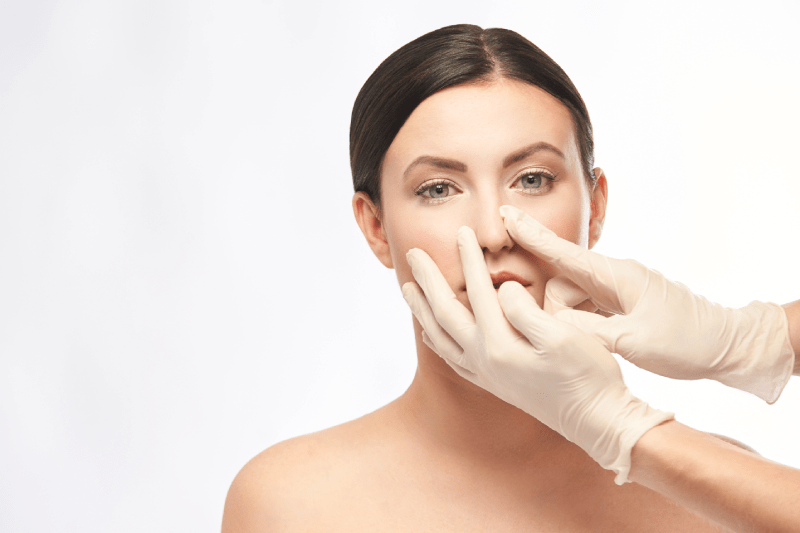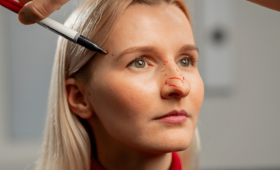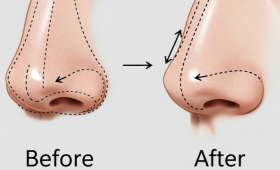What is the fundamental difference between a surgical and a non-surgical nose job?
Surgical rhinoplasty, also known as a nose job, is a comprehensive surgical operation that involves permanent changes to the bone, cartilage, and soft tissues of the nose. It provides lasting results and is ideal for correcting significant deformities.
Non-surgical rhinoplasty, on the other hand, is a minimally invasive procedure typically using dermal fillers (usually hyaluronic acid) to temporarily address issues like nasal dorsum depressions, asymmetries, or a drooping nasal tip. This method cannot permanently reduce the size of the nose.
When is a surgical operation required, and when can non-surgical methods be used?
If a patient wishes to reduce a dorsal hump, narrow the nostrils, correct a nasal bone deviation, or permanently change the size of their nose, a surgical operation is necessary. These types of fundamental changes are only possible through surgery.
Non-surgical methods are more suitable for smaller and temporary aesthetic issues, such as filling in slight depressions on the nasal bridge, lifting a drooping nasal tip, or correcting minor nasal asymmetries.
Are the results of both methods permanent?
The results of surgical rhinoplasty, when performed correctly and after the full recovery period, are permanent. The new nasal shape achieved through surgery is maintained for the rest of the patient’s life. The results of a non-surgical nose job (dermal fillers) are temporary. The results typically last between 6 to 18 months, depending on the type of filler used and the patient’s metabolism. The procedure needs to be repeated regularly to maintain the effect.
What is the difference in terms of procedure duration?
Surgical rhinoplasty is an operation performed under anesthesia in a hospital setting, typically lasting between 2 to 4 hours. This duration can vary depending on the complexity of the issue and the techniques to be applied. A non-surgical nose job is a much simpler procedure, done in a clinic, and usually takes a much shorter time, around 15 to 30 minutes, after a local anesthetic cream is applied. This short duration is an attractive option for patients with busy schedules.
Do both methods involve intervention on the nasal bone?
No, only surgical rhinoplasty directly intervenes with the bone and cartilage structure of the nose. During rhinoplasty, the dorsal hump can be removed, nasal bones can be narrowed, or the cartilage at the nasal tip can be reshaped. In non-surgical rhinoplasty, there is no intervention on bone or cartilage. This method only involves injecting a filler material under the skin of the nose to change its external appearance.
How is anesthesia used?
Surgical rhinoplasty is typically performed under general anesthesia for the patient’s comfort and the surgeon’s ability to work safely. The patient is completely asleep during the operation. Non-surgical rhinoplasty is much simpler and usually requires only a local anesthetic cream applied before the procedure to numb the area. This allows the patient to remain awake throughout the process and return home immediately afterward.
How long is the recovery process and return to social life?
The recovery period after surgical rhinoplasty is longer. Swelling and bruising are at their peak during the first few days. The cast or splint on the nose is usually removed after one week. The full recovery and final result can take 6 to 12 months to settle. After a non-surgical nose job, the recovery process is almost nonexistent. Mild redness and swelling may occur after the procedure, but this usually subsides within a few hours, and the patient can immediately return to their social life.
Which method has higher risks?
Surgical rhinoplasty, being a surgical operation, carries higher risks such as infection, bleeding, complications related to anesthesia, and undesirable aesthetic outcomes. These risks can be minimized by choosing an experienced surgeon. Non-surgical rhinoplasty is less risky, but it still carries risks such as tissue damage, vascular occlusion, or allergic reactions if the injection is done incorrectly. The most crucial factor for both methods is the expertise and experience of the person performing the procedure.
Why is surgical rhinoplasty popular in Turkey?
Turkey has become a global hub for surgical rhinoplasty due to its expert team of aesthetic surgeons and more affordable prices compared to other countries. Turkish surgeons often have a large international patient base, which allows them to gain experience with various nasal structures and aesthetic expectations. The high quality of service, technological infrastructure, and additional services like accommodation make Turkey an attractive destination.
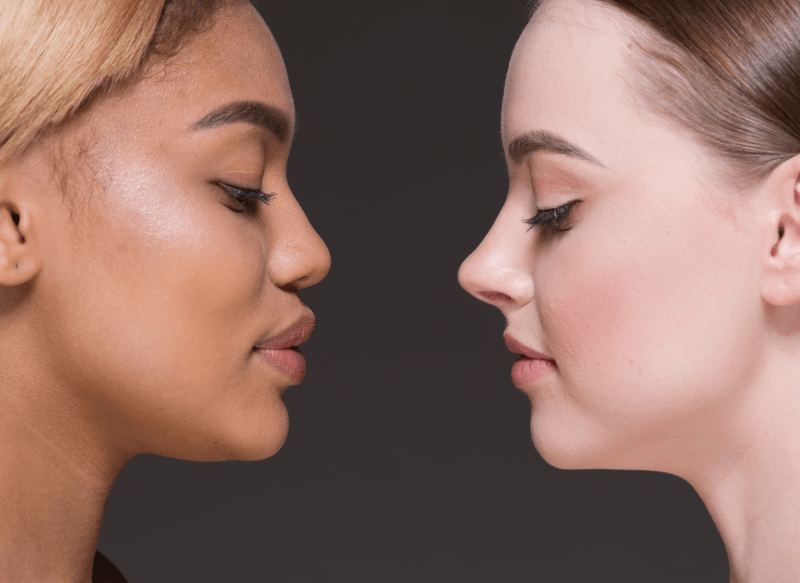
Why is the demand for non-surgical nose jobs increasing in Turkey?
The demand for non-surgical rhinoplasty in Turkey is rapidly increasing due to factors like the short procedure time, minimal recovery, and lower cost. Patients who want to make minor changes to their nose without the risks and long recovery times of surgery are opting for this method. The popularization of the “lunchtime facelift” concept through social media has also contributed to this increased demand.
What aesthetic problems does surgical rhinoplasty solve?
Surgical rhinoplasty is an operation that can fundamentally change the aesthetic appearance of the nose. With this method, issues such as reducing or completely straightening a nasal hump, lifting or thinning the nasal tip, narrowing the nostrils, and correcting nasal bridge deviations can be permanently solved. Additionally, functional problems like a deviated septum that causes breathing difficulties can be addressed in the same operation.
How long does a surgical nose job take?
The duration of a nose job varies depending on the complexity of the patient’s nasal issues and the technique the surgeon will use. A simple operation typically takes between 1.5 to 2 hours, while more complex revision surgeries or cases requiring significant changes to the bone and cartilage structure can take up to 4 hours. This duration does not include the time for anesthesia preparation and waking up.
How long do swelling and bruising last after surgery?
It is normal for swelling and bruising to occur around the eyes and nose immediately after the operation. This condition usually peaks within the first 24 to 48 hours. Bruising largely disappears within the first 7-10 days. Swelling can last longer; while major swelling subsides within a few weeks, the fine swelling on the nasal tip and bridge can take 6 to 12 months to completely disappear.
How long does it take to fully recover and see the final result?
Full recovery and the nose settling into its final shape after a surgical rhinoplasty is a long process. While bruising and initial swelling fade within a few weeks, the final result may not be fully visible for 6 to 12 months as the edema on the nasal tip and bridge slowly decreases. Therefore, it is crucial to be patient and follow your doctor’s instructions to see the true outcome of the surgery. Full recovery varies from one patient to another.
Is there pain after rhinoplasty?
Thanks to modern rhinoplasty techniques and pain medications, post-operative pain is usually minimal and easily manageable. Patients often describe a “pressure sensation” or “fullness” rather than pain. This discomfort is alleviated with prescribed pain relievers during the first few days. These sensations typically decrease within a few days, and patients can return to their daily activities.
What is revision rhinoplasty and when is it performed?
Revision rhinoplasty is a second operation performed to correct undesirable outcomes in patients who have previously undergone a nose job. It is typically sought due to dissatisfaction with the first surgery’s results, asymmetry, breathing problems, or unmet aesthetic expectations. Revision rhinoplasty is performed at least one year after the initial surgery to ensure that the nasal tissues have fully healed.
What is the difference between open and closed rhinoplasty?
Open rhinoplasty is performed by making a small incision between the nostrils, lifting the nasal skin, and making the nasal structure fully visible to the surgeon. This method provides the surgeon with a wider field of view, which is beneficial for complex cases or when detailed shaping of the nasal tip is needed. Closed rhinoplasty involves all incisions being made inside the nose, leaving no visible external scars. It may be preferred for simpler cases.
Can the nasal tip drop after rhinoplasty surgery?
In modern rhinoplasty techniques, supporting the nasal tip is very important. During the operation, the surgeon uses special sutures or grafts to strengthen the nasal tip cartilage and create a stable structure. This minimizes the risk of the nasal tip permanently dropping after the surgery. It is normal for the nasal tip to descend slightly after the initial swelling goes down in the first few months, but this is not considered a “drop.”
What should be considered after a surgical nose job?
The post-operative process is critical for the success of the outcome. The patient should use the nasal splint or cast as instructed by the doctor, avoid strenuous activities for the first few weeks, be careful not to hit the nose, and keep their head elevated while sleeping. Additionally, smoking and alcohol consumption can negatively affect the healing process, so it is recommended to avoid them.
Why is a nasal massage important after surgery?
The nasal massage recommended by doctors after a nose job is performed to help reduce post-operative edema and swelling more quickly. The massage increases lymphatic drainage, accelerating the removal of fluid that has accumulated in the nasal tissues. This practice also contributes to the final shape of the nose settling more quickly. The method and frequency of the massage must be determined by the doctor.
How is a non-surgical nose job performed?
A non-surgical nose job is performed by injecting hyaluronic acid-based dermal fillers into the nose with a fine needle or cannula. The doctor strategically injects the filler into specific points to fill in depressions, correct asymmetries, or lift a drooping nasal tip. The procedure is shaped according to the patient’s wishes and nasal structure, and the results are visible immediately.
What types of fillers are used?
The most common filler used in non-surgical rhinoplasty is hyaluronic acid, a substance found naturally in the body. Hyaluronic acid is preferred because of its safety and reversibility. In some cases, other fillers with longer-lasting effects may also be used. It is important that these fillers are biocompatible and do not cause allergic reactions. The choice of filler to be used during the procedure will be determined by your doctor.
Can nasal bone deviations be corrected with this method?
No, nasal bone deviations cannot be corrected with a non-surgical nose job. The filler material only fills the volume deficiencies on the surface of the nose, masking the shadow and appearance created by the bone deviation. This procedure makes the overall nasal profile appear straighter and more symmetrical, but it does not change the underlying bone structure or correct the bone. The only solution for severe bone deviations is surgical rhinoplasty.
What are the advantages of a non-surgical nose job?
The biggest advantages of a non-surgical nose job include a short procedure time, being non-surgical, minimal recovery, and immediate results. Patients can return to their social lives immediately after the procedure. It is also significantly more affordable compared to surgery. The temporary nature of the results provides patients with an opportunity to “try out” their new nasal shape.
What are the disadvantages?
The main disadvantage of a non-surgical nose job is that the results are temporary. The procedure needs to be repeated for the effect to last, which can increase the total cost in the long run. This method cannot reduce the size of the nose or fix severe bone/cartilage problems. There are also serious risks such as tissue damage and vascular occlusion if the injection is done incorrectly. Therefore, it is vital that the procedure is performed by a qualified and experienced doctor.
How much pain does the procedure cause?
The non-surgical nose job procedure is generally painless. Anesthetic cream is applied to the nasal area before the procedure to ensure sufficient numbness. Patients may feel a slight pressure or stinging sensation while the filler is being injected. Most patients describe this sensation as “tolerable.” There is usually no pain felt after the procedure.
How long does the effect last?
The duration of the effect in a non-surgical nose job depends on the type of filler used and how quickly the patient’s body metabolizes it. Generally, hyaluronic acid-based fillers last between 6 to 18 months. At the end of this period, the filler gradually dissolves, and the nose returns to its original shape. The procedure needs to be repeated at certain intervals to maintain the effect.
Can I return to my social life immediately after the procedure?
Yes, a patient can return to their social life immediately after a non-surgical nose job. Unlike surgery, there is no significant swelling, bruising, or a cast to hinder them. Mild redness or swelling may be visible, but this usually subsides within a few hours. This feature makes the method very attractive for people with busy work or social lives.
Can the nose be made smaller with a non-surgical procedure?
No, the nose cannot be made smaller with a non-surgical nose job. On the contrary, this procedure adds volume to the nose by injecting filler into the nasal bridge. This method creates a visual illusion by filling the nasal hump to make the profile appear straighter. In reality, the nasal volume increases slightly. The only method to permanently make the nose smaller is surgical rhinoplasty.
In what situations is the non-surgical method insufficient?
A non-surgical nose job is insufficient for cases like nose reduction, narrowing the nostrils, correcting severe bone deviations, or solving breathing problems. The filler only temporarily corrects the external aesthetic appearance. For fundamental changes to the nasal structure and functional corrections, surgical rhinoplasty is mandatory.
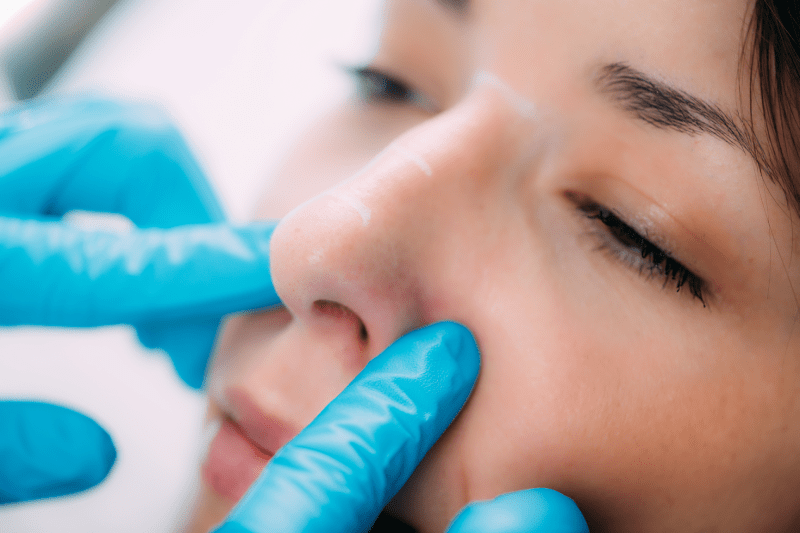
What determines the cost of a surgical nose job in Turkey?
The cost of a surgical nose job in Turkey varies depending on many factors, such as the surgeon’s experience, the quality of the hospital where the operation will be performed, the type of anesthesia used, and the complexity of the operation. Additionally, if the patient has a functional problem in their nasal structure (e.g., septum deviation), this can also affect the cost. Package prices that include all these services are often offered.
What is the cost of a non-surgical nose job?
The cost of a non-surgical nose job is lower compared to surgery. The price is usually determined by the brand and quantity of the filler used. Since the procedure is temporary, it must be repeated at regular intervals (usually once a year) to maintain the effect, which can increase the total cost in the long run.
Does health insurance cover these procedures?
Most health insurance policies do not cover procedures for aesthetic purposes. If surgical rhinoplasty is performed due to a medical necessity, such as correcting a deviated septum that causes breathing difficulties, the functional part of the operation may be partially or fully covered by insurance. However, non-surgical procedures are entirely for aesthetic purposes and are therefore not covered by insurance.
Are there other advantages to choosing Turkey for a nose job besides the cost?
Turkey stands out for a nose job not only for its affordable costs but also for its “health tourism” infrastructure, which offers comprehensive services like post-operative accommodation, transfers, and consultation. Clinics that provide services in English and other languages facilitate communication for patients. Additionally, Turkey’s geographical and cultural richness offers an opportunity for a pleasant vacation during the recovery period.
How can I choose the best doctor or clinic?
To choose the best doctor or clinic in Turkey, you need to do extensive research. Review the surgeon’s resume and experience, and evaluate previous patient reviews and before/after photos. Your doctor’s communication skills and how well they understand your expectations are also very important. Do not hesitate to ask all your questions during the initial consultation and choose a professional you feel confident in.
Is psychological counseling necessary before the operation or procedure?
Psychological counseling can be beneficial for some patients before a nose job. This counseling helps the patient to understand if their aesthetic expectations are realistic and to mentally prepare for the post-procedure change. It is a critical factor for the success and satisfaction of the procedure that your doctor understands your emotional well-being and expectations.
Are travel and accommodation expenses included in the total cost to Turkey?
Most health tourism agencies or clinics offer package prices for surgical rhinoplasty. These packages usually include the surgery fee, hospital stay, accommodation, and airport transfers. However, these additional expenses are generally not included in the price for non-surgical nose jobs. It is important to discuss in detail with the clinic or agency beforehand to find out what services are included in the package.
What is the ideal age range for rhinoplasty surgery?
The ideal age for a nose job is when the bone and cartilage development of the nose is complete. This is usually around 16-17 for girls and 17-18 for boys. However, every individual’s development is different. Operations performed at a young age may require revision in the future because facial development has not been completed. Apart from the lower age limit, there is no upper age limit for the operation, but factors like age-related skin elasticity can affect the outcome.
Can a nasal tip lift be performed without surgery?
Yes, a nasal tip lift can be performed with a non-surgical nose job. This procedure is called “nasal tip aesthetics” or “nasal tip filler.” Filler material is injected into the columella region right below the nasal tip to make it lift upward. This procedure is a quick and effective solution for patients who complain of a drooping nasal tip but do not want a surgical operation.
Can a non-surgical procedure be done after a surgical one?
Yes, it is possible to have a non-surgical procedure after a surgical rhinoplasty. Mild asymmetries or depressions remaining on the nasal bridge after surgery can be easily corrected with a filler injection. This method offers a simpler and less risky solution than undergoing a revision surgery. However, you should definitely consult your surgeon about when and how to perform such a procedure.
